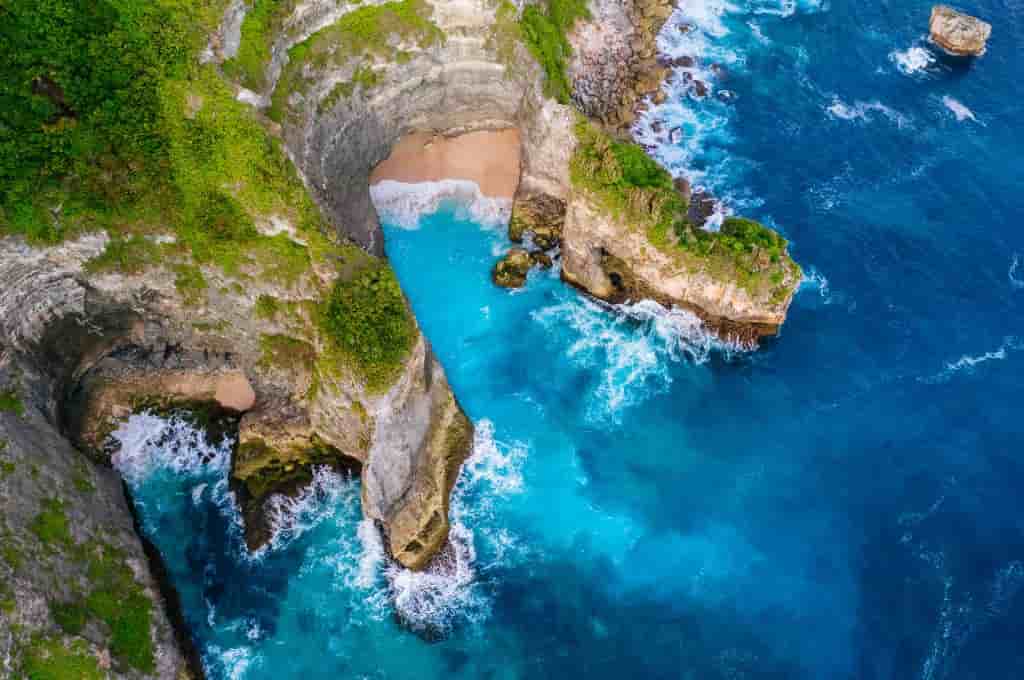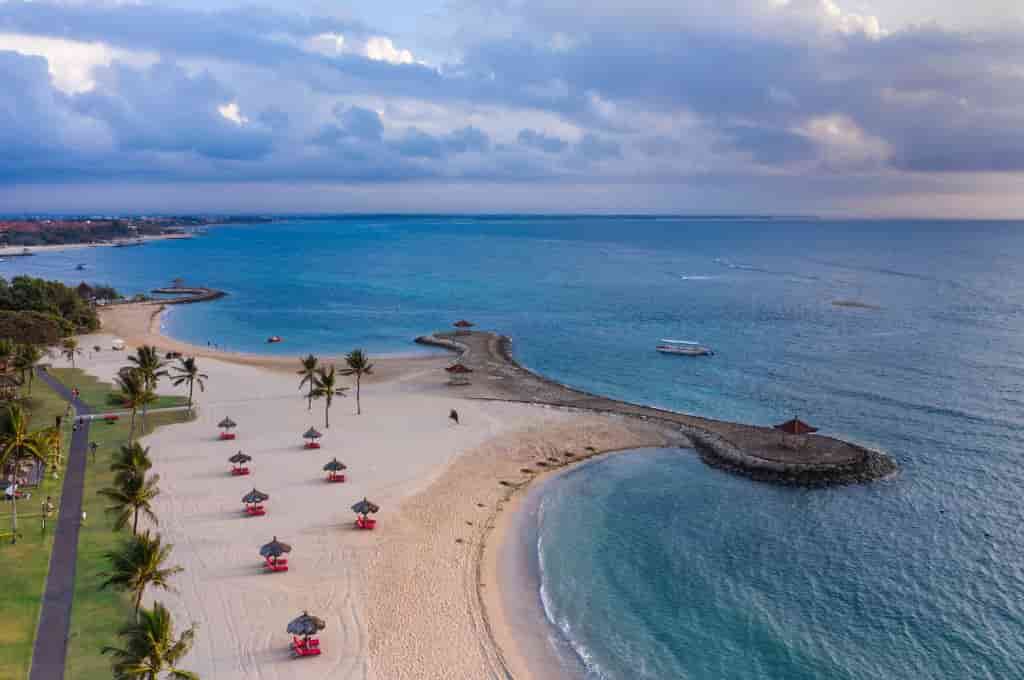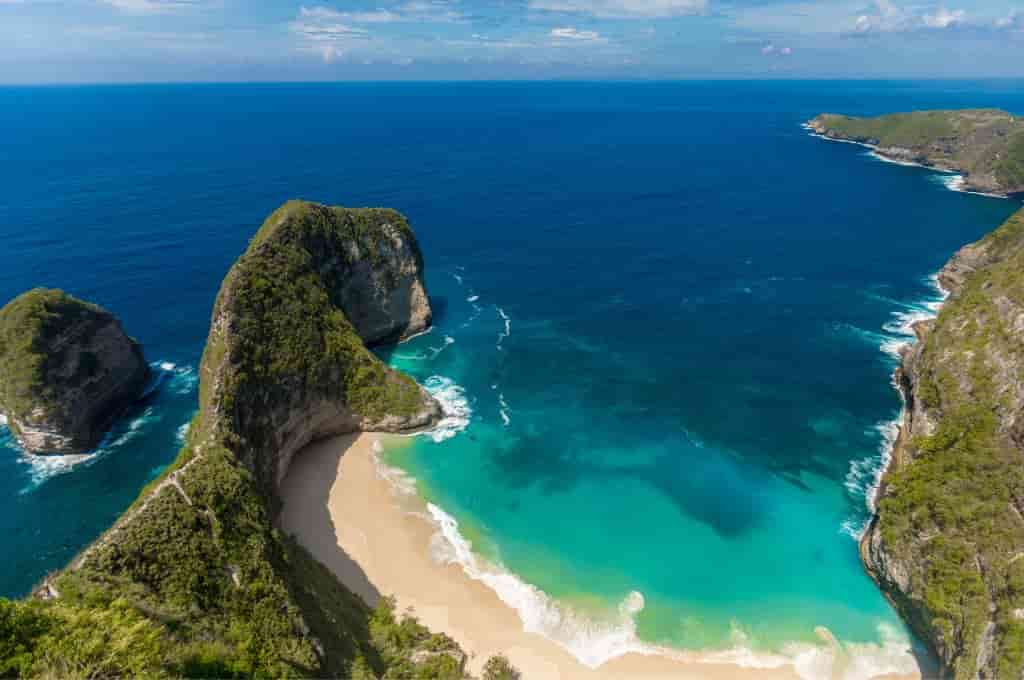Bali Travel Tips
- By Seema
- Updated on 15th July, 2025
Bali is the ultimate destination for travelers looking for fun, adventure, relaxation, and a rich cultural experience. Renowned for its wellness retreats, pleasant weather, coral-speckled beaches, magical sunsets, and verdant rice terraces, Bali is on everyone’s list. If the breathtaking natural beauty isn’t enough to wow you, add in the welcoming locals, infectious culture, and mouthwatering culinary scene, and you’ve got everything you need for a wonderful vacation.
However, Bali has its own set of challenges and frustrations. If you’re planning a trip to this tropical paradise, be aware of a few essentials to ensure a smooth and pleasant stay. From understanding local customs and highlighting top attractions to figuring out the transportation system and identifying the best places to stay, this comprehensive Bali travel guide has everything you need to plan your trip to Bali.

Overview of Bali
Indonesia has more than 17,000 islands, the majority of which are unexplored and uninhabited. However, Bali stands out. The tourism boom in Bali began in the 1980s, but it hit some rough patches. It received a major boost when many scenes of the 2010 hit film ‘Eat Pray Love’ were filmed on the island. On the map, Bali appears to be a small island, but in reality, it is quite big. Aside from the main island, Bali encompasses the Nusa islands (Nusa Lembongan, Nusa Ceningan, and Nusa Penida). Known as “the island of gods,” Bali offers a diverse range of experiences that attract tourists from all over the world, drawn to the island’s beauty and magic.
Visa
Most nationalities can enter Bali by obtaining a Visa on Arrival at the airport, as long as their passport is valid for a least six months from the day of entry to Bali. VOA costs roughly $30 and can be bought at the airport with cash or a credit card. You can make things much easier by applying for an electronic Visa on Arrival (e-VOA) through the official website before visiting Bali. An e-VOA is the quickest and most convenient way to get a visa for Indonesia. The process takes only a few minutes, and you avoid the hassle of waiting in line to pay for your visa at the airport. The VOA and e-VOA permit you to enter Indonesia for 30 days, which can be extended for an additional 30 days.

When’s the best time to visit Bali?
Bali is an amazing destination to visit at any time of the year. It has fairly consistent year-round temperatures, which average 27 degrees. The best time to visit Bali is during the dry season, which typically lasts between April and September. The bright, warm, and dry conditions are ideal for outdoor pursuits such as diving, swimming, exploring, and relaxing by the beach. July and August are Bali’s busiest travel months, characterized by a high volume of tourists and significantly higher rates. Therefore, it’s best to book your accommodations and flights in advance. March to October is the rainy season, characterized by high humidity, strong winds, and frequent rainfalls. But don’t be dissuaded by the showers. Rainfall is usually brief and sharp, so it is unlikely to mess up your vacation plans. Bali becomes lush, green, and spectacular, offering fewer tourists and lower prices.
Where to stay in Bali?
The location of your accommodation in Bali has a significant impact on the type of experience you will have. The island is vast and offers a diverse range of accommodations, including hotels, hostels, apartments, and villas for rent. Each region has its distinct charm and flavor, so your decision should be based on your preferences and what you intend to do during your vacation. The key is to select an area that allows for easier and quicker access to desired attractions and facilities. Tourists who are visiting for an extended period usually divide their stays into 2-3 locations, so they do not waste time in traffic and can fully explore the region before moving on to the next location.

- Kuta is a popular destination for budget travelers due to its affordable accommodations and lively nightlife. The endless stretches of beaches and perfect waves make it an ideal spot for surfers and party lovers. The drawback of staying here is that the entire area is overly touristy, with numerous construction sites nearby.
- Seminyak is great for those seeking a balance of relaxation and nightlife while enjoying the good things in life. Positioned on the southwestern coast of Bali, Seminyak is a central and highly favored area for visitors to the island. It is home to some of the finest luxury hotels, chic villas, gourmet restaurants, sunset beach clubs, and trendy boutiques in the entire country. There are accommodations available for every budget. The area’s primary drawback is that it is largely designed for tourists.
- Canggu is the preferred location for digital nomads and expats. Canggu is similar to Seminyak but more laid-back and relaxed, with a thriving surf culture and café scene. Located on Bali’s southwestern coast, the island’s trendiest neighborhood is dotted with hip cafes, yoga retreats, Pilates studios, charming villas, and co-living spaces. The sandy beaches entice surfers and beach enthusiasts to linger.

- Ubud is the heart of Bali – the hub where culture, luxury, and nature coexist in perfect harmony. Nestled in the lush greenery of central Bali, this idyllic location is surrounded by rice paddies and impressive jungle landscapes. With its stunning temples, numerous workshops, charming art markets, friendly locals, and serene atmosphere, Ubud is a must-see destination. Many people come here to recuperate, meditate, and participate in yoga classes. Ubud is ideal for those seeking peace, spirituality, and a more profound cultural experience.
- Nusa Dua is Bali’s most upscale resort destination, known for its international hotel brands, deluxe spas, exclusive golf courses, high-end restaurants, and hip cafes. Everything, including water activities, is pricey. Nusa Dua Beach, with its clear waters and golden sands, is the region’s prime attraction.
- Nusa Penida is only a short boat ride from the mainland, but it allows you to see some of Bali’s most spectacular and Instagrammable views. A visit to the breathtaking Nusa Islands is a must-see if you’re in Bali. And there are so many places to visit that you will need at least a day or two. You can book your stay in Nusa Penida or Nusa Lembongan.

Where to go in Bali?
Every corner of Bali offers something unique, with its distinct charm. You can decide where to go based on your interests and discover the wonders that await you. If you plan to visit several different districts during your trip, consider creating an itinerary that takes the most efficient routes and allows you to see the best of the area while you’re there.
Southern Bali includes tourist hotspots such as Seminyak, Kuta, Seminyak, and Nusa Dua. The capital city of Bali, along with the Gusti Ngurah Rai International Airport, is located in southern Bali. The region is famed for its upscale resorts, vibrant sunsets, and stunning beaches.
Best places to visit in South Bali: Uluwatu Temple, Tanah Lot, Nusa Dua Beach, Jimbaran Beach, Kuta Beach, Tegenungan Waterfall, Sanur Beach
Central Bali – Bali’s central area is both the cultural heart of the island and its most beautiful side. The highlight is Ubud, a center for traditional crafts and dance. The lush green rice terraces, magnificent waterfalls, deep river gorges, magnificent temples, and serene atmosphere make it an inevitable stop on your Bali itinerary.
Best places to visit in Central Bali: Ubud Monkey Forest, Tegalalang Rice Terraces, Goa Gajah Cave, Pura Tirta Empul, Tegenungan Waterfall, and Campuhan Ridge Walk

Eastern Bali – Mount Agung, Bali’s largest volcano, dominates the eastern part of the island. As this volcano is very active and erupts frequently, visitors are not permitted. Mount Batur, another active volcano in the region, is still safe and open to hikers. The coastal villages and scenic views are additional attractions in Eastern Bali
Best places to visit in East Bali: Mount Agung, Mount Batur, Tirta Gangga, Taman Ujung Water Palace, Gates of Heaven, Virgin Beach
Northern Bali – North Bali shows a different side of Bali. Although this vast region is home to one-sixth of the island’s population, visitors often overlook it. North Bali offers an authentic, rejuvenating vacation with hidden gems and fewer tourists. Rainfall is common in the region, resulting in cloudy mountains, shimmering lakes, wildlife sanctuaries, and numerous waterfalls.
Best places to visit in North Bali: Munduk Moding Plantation, Git Git Waterfall, Wanagiri Hidden Hill, Pura Ulun Danu Bratan, Banyumala Twin Waterfalls, Sekumpul Waterfall, Handara Gate, Banjar Hot Springs, Ulun Danu Water Temple, & Lovina Beach

Western Bali – Western Bali is best known for its rugged landscapes and traditional Balinese culture. It is a great destination for those exploring beyond the island’s tourist-centric areas. West Bali Northern Park is undoubtedly a haven for adventure lovers and nature enthusiasts.
Best places to visit in West Bali: West Bali Northern Park, Majapahit Temple, Candikusuma Beach & Juwuk Manis Waterfall
Nusa Islands – If you want to see how Bali looked two decades ago, go to the Nusa Islands. The islands remain largely untouched and unexplored. Expect white-sand beaches, vibrant blue waters, dramatic cliffs, and phenomenal views. Discover the highlights of the three Nusa Islands: Nusa Penida, Nusa Lembongan, and Nusa Ceningan.
Getting Around in Bali
Bali traffic can be chaotic, congested, and unpredictable, often resulting in prolonged traffic jams. haotic, crowded, and unpredictable, often resulting in extremely unreliable estimated journey times on apps like Google Maps and Grab. To make the most of your Bali trip and avoid traffic congestion, plan your routes carefully and travel during off-peak hours.
- Taxi – Bali’s public transportation is limited, so taxis or private vehicles are the most convenient way to get around. Taxis are inexpensive and suitable for simple A-to-B trips. However, they refuse to use meters, and bargaining can be a hassle. Furthermore, they are difficult to find during peak travel times, when there is a large influx of tourists and locals. If you do take taxis, try to use Bluebird taxis. They are the safest and will continuously operate the meter. They have been touted as the most reliable taxi operator in Bali

- Ride-Sharing Apps – Booking a taxi through an online app such as Grab, Gojek, or Bluebird Taxis is a very convenient option in Bali. Payments can be made in cash or with credit cards. When booking an online taxi, you can choose between a scooter taxi and a car taxi. Scooter taxis are naturally cheaper and faster. Specific tourist destinations do not allow car taxis booked through Ride-Sharing Apps into their premises, but bikes are permitted. Gojek isn’t just a transportation app. You can have food, wine, medications, or any other items delivered to your hotel or villa.
- Private Car Driver – Hiring a private chauffeur-driven car is recommended if you are planning a day trip with multiple stops or if you have luggage. It provides more customized service as well as the flexibility to explore. You can hire a private car with a driver for $35 per day. Many of the drivers are conversant guides who will share information about the island’s culture, history, shopping, and attractions. Furthermore, they will help you plan your itinerary and look after all your belongings.
- Rent a Motorbike/Scooter – Two-wheelers are the preferred mode of transportation for both locals and visitors to Bali. You can travel faster and farther on a motorcycle, given that most of Bali’s winding roads are too narrow and congested for cars. A bike can be rented for as little as $7 per day. However, only ride a motorcycle/scooter if you have some prior experience and are comfortable driving one. A valid international driver’s license is required if you intend to rent a bike. Familiarize yourself with roads and traffic rules, and always wear a helmet.

Cultural and Religious Etiquettes
Indonesia is predominantly Muslim, but approximately 85 percent of Bali’s population follows Hinduism. There is no rigid protocol, but you are expected to follow specific rules when entering temples and attending religious ceremonies. Take off your shoes before entering the temple grounds. Dress modestly, covering your knees and shoulders. Visitors are given free sarongs to wear at many temples and religious sites. Certain temples might prohibit women from entering while they are menstruating or require them to tie back their hair. Small fragrant parcels known as ‘canang sari’ are frequently spotted on the ground or in front of temples, shops, and homes. Stepping over or disturbing them in any way is considered inappropriate. You should always shake hands and accept or give things to people using your right hand.
Bonus Tips
- Bali is very affordable, as the cost of living in Bali is relatively low. Everything here is much cheaper than in Europe, America, and even India. Bali can be enjoyed on a budget, but for those seeking a lavish vacation, the island offers a plethora of luxurious retreats, fine dining establishments, and exclusive experiences. The fact that you can have a fantastic time in Bali on any budget is what makes it unique.
- The amount of time you should spend in Bali is determined by what you want to see and do. It is impossible to experience Bali in a week, as the distances and traffic significantly slow you down. To fully explore Bali, it is recommended that you spend at least two weeks there, especially if you’re flying from halfway around the world. If you live nearby, you’re always welcome to come back.

- Mosquitoes can be problematic in Bali. Bug bites are itchy and can spread insect-borne diseases, such as dengue and malaria. So, bring some strong repellent creams and bug spray and keep them handy. Wear long, loose clothing that covers your skin and keeps you safe from bug bites.
- Bali is located near the equator, which means that the sun is intense and can cause sunburn and skin damage. It is advised that you use a broad-spectrum sunscreen with a high SPF at all times. In addition to sunscreen, hats, umbrellas, and sunglasses should be used to protect your skin from the sun’s harmful rays.
- The Indonesian Rupiah (IDR) is the local currency in Bali. Card payments are generally accepted, but it’s recommended to carry some cash with you. Small amounts of money are needed for things like gas, parking, drivers, small eateries, shopping, temples, and waterfalls.
- It’s not necessary to bring cash when traveling to Bali. ATMs are located throughout the island, including at the airport. Most cards do not charge any fees for international withdrawals. It is best to withdraw cash from a well-known bank’s ATM and avoid money changers, as they have been known to short-charge customers.
- Tipping is not mandatory but is always appreciated. Although the locals aren’t expecting tips, they are grateful when they get one. If you get superb service, be sure to tip generously.
- Don’t be afraid to bargain for a better deal while shopping in Bali. When buying goods from stalls and markets, there is usually a large margin to work with. Browse around to get an estimate of the real price. Often, an item can be purchased for 40 percent of what was initially proposed. Just start to leave if you don’t think you are being given a fair price, and they usually lower it promptly
- The tap water in Bali is unsafe to drink. Rely on bottled water, which is readily accessible and very affordable. Or use reusable bottles, as refilling facilities are becoming easier to find in Bali. Drinking water is typically available at most hotels and guesthouses.
- Bali Belly is a moniker given to ‘travelers’ diarrhea’ in Bali. It is caused by consuming contaminated food or water and can quickly ruin the vacation. Avoiding tap water, street food, and raw fruits/vegetables can lower the risk of developing Bali Belly. Pack some Imodium/Charcoal tablets, be mindful of your diet, and stay hydrated.
- Traffic is an unavoidable part of Bali, and visitors should be mentally and physically prepared for it. Don’t expect vehicles to stop for pedestrians at zebra crossings. Motorcyclists occasionally use footpaths as roads, so be extra cautious when walking on busy streets. To avoid colliding with someone on a scooter, exit from cars on the footpath side.
- Credit card scams are also prevalent in Bali, with fraudsters cloning your card or stealing your information. Only use your card at trustworthy ATMs and businesses, and monitor it closely during all transactions.
